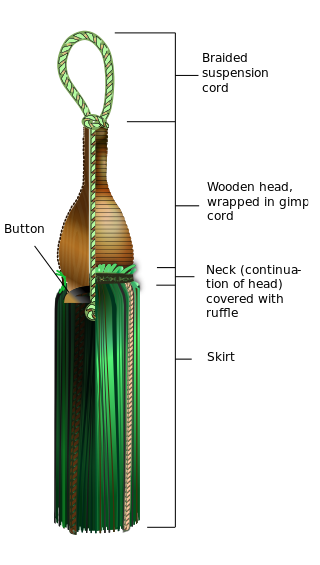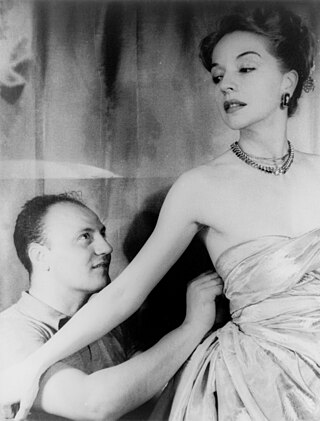
A tassel is a finishing feature in fabric and clothing decoration. It is a universal ornament that is seen in varying versions in many cultures around the globe.

1860s fashion in European and European-influenced countries is characterized by extremely full-skirted women's fashions relying on crinolines and hoops and the emergence of "alternative fashions" under the influence of the Artistic Dress movement.

1870s fashion in European and European-influenced clothing is characterized by a gradual return to a narrow silhouette after the full-skirted fashions of the 1850s and 1860s.

1830s fashion in Western and Western-influenced fashion is characterized by an emphasis on breadth, initially at the shoulder and later in the hips, in contrast to the narrower silhouettes that had predominated between 1800 and 1820.

A frog is a type of ornamental braiding closure made out of cord, consisting of a button and a loop; it is used to fasten garments without creating an overlap. Its purpose is to act as a fastener as well as providing a decorative closure for the garment. It is especially used on the cheongsam, where the frog represents the cultural essence of the dress.

A dressmaker, also known as a seamstress, is a person who makes clothing for women, such as dresses, blouses, and evening gowns. Dressmakers were historically known as mantua-makers, and are also known as a modiste or fabrician.

Gimp is a narrow ornamental trim used in sewing or embroidery. It is made of silk, wool, polyester, or cotton and is often stiffened with metallic wire or coarse cord running through it. Gimp is used as trimming for dresses, curtains, furniture, etc. Originally the term referred to a thread with a cord or wire in the center, but now is mainly used for a trimming braided or twisted from this thread. Sometimes gimp is covered in beads or spangles.

1850s fashion in Western and Western-influenced clothing is characterized by an increase in the width of women's skirts supported by crinolines or hoops, the mass production of sewing machines, and the beginnings of dress reform. Masculine styles began to originate more in London, while female fashions originated almost exclusively in Paris.
A dolman is either a military shirt, or a jacket decorated with braiding, first worn by Hungarian hussars. The word is of Turkish origin, and after being adopted into Hungarian, has propagated to other languages. The garment was worn by peasants from the 16th century onward and eventually spread throughout the country, mainly within wealthy peasant circles. It reached people living in the poorest conditions only at the end of the 19th century.

A buttonhole is a reinforced hole in fabric that a button can pass through, allowing one piece of fabric to be secured to another. The raw edges of a buttonhole are usually finished with stitching. This may be done either by hand or by a sewing machine. Some forms of button, such as a frog, use a loop of cloth or rope instead of a buttonhole.

Fashion in the period 1550–1600 in European clothing was characterized by increased opulence. Contrasting fabrics, slashes, embroidery, applied trims, and other forms of surface ornamentation remained prominent. The wide silhouette, conical for women with breadth at the hips and broadly square for men with width at the shoulders had reached its peak in the 1530s, and by mid-century a tall, narrow line with a V-lined waist was back in fashion. Sleeves and women's skirts then began to widen again, with emphasis at the shoulder that would continue into the next century. The characteristic garment of the period was the ruff, which began as a modest ruffle attached to the neckband of a shirt or smock and grew into a separate garment of fine linen, trimmed with lace, cutwork or embroidery, and shaped into crisp, precise folds with starch and heated irons.

Fashion in the period 1700–1750 in European and European-influenced countries is characterized by a widening silhouette for both men and women following the tall, narrow look of the 1680s and 90s. This era is defined as late Baroque/Rococo style. The new fashion trends introduced during this era had a greater impact on society, affecting not only royalty and aristocrats, but also middle and even lower classes. Clothing during this time can be characterized by soft pastels, light, airy, and asymmetrical designs, and playful styles. Wigs remained essential for men and women of substance, and were often white; natural hair was powdered to achieve the fashionable look. The costume of the eighteenth century, if lacking in the refinement and grace of earlier times, was distinctly quaint and picturesque.

Fashion in the period 1500–1550 in Europe is marked by very thick, big and voluminous clothing worn in an abundance of layers. Contrasting fabrics, slashes, embroidery, applied trims, and other forms of surface ornamentation became prominent. The tall, narrow lines of the late Medieval period were replaced with a wide silhouette, conical for women with breadth at the hips and broadly square for men with width at the shoulders. Sleeves were a center of attention, and were puffed, slashed, cuffed, and turned back to reveal contrasting linings.
The manufacture of textiles is one of the oldest of human technologies. To make textiles, the first requirement is a source of fiber from which a yarn can be made, primarily by spinning. The yarn is processed by knitting or weaving, which turns yarn into cloth. The machine used for weaving is the loom. For decoration, the process of colouring yarn or the finished material is dyeing. For more information of the various steps, see textile manufacturing.

In sewing and dressmaking, a ruffle, frill, or furbelow is a strip of fabric, lace or ribbon tightly gathered or pleated on one edge and applied to a garment, bedding, or other textile as a form of trimming.

Passementerie or passementarie is the art of making elaborate trimmings or edgings of applied braid, gold or silver cord, embroidery, colored silk, or beads for clothing or furnishings.

Grosgrain is a type of fabric or ribbon defined by the fact that its weft is heavier than its warp, creating prominent transverse ribs. Grosgrain is a plain weave corded fabric, with heavier cords than poplin but lighter than faille, and is known for being a firm, close-woven, fine-corded fabric. Grosgrain has a dull appearance, with little luster in comparison to many fabric weaves, such as satin, often used for ribbons; however, it is comparatively very strong. Grosgrain fabric is most commonly available in black, but grosgrain ribbon comes in a large variety of colors and patterns. The ribbon is very similar to Petersham ribbon in its appearance, but it does not have the ability to follow the curves of a surface or edge the way that the latter does.

Soutache, also known as Russia braid, is a narrow flat decorative braid, a type of galloon, used in the trimming of drapery or clothing. Soutache is created by weaving a decorative thread around and between two parallel cords and completely covering the cores; this produces a piece of trim with a braided or herringbone pattern. Often woven of metallic bullion thread, silk, or a blend of silk and wool, soutache began to be made of rayon and other synthetic fibers in the 20th century.
Sewing is the craft of fastening or attaching objects using stitches made with needle and thread. Sewing is one of the oldest of the textile arts, arising in the Paleolithic Era. Although usually associated with clothing and household linens, sewing is used in a variety of crafts and industries, including shoemaking, upholstery, sailmaking, bookbinding and the manufacturing of some kinds of sporting goods. Sewing is the fundamental process underlying a variety of textile arts and crafts, including embroidery, tapestry, quilting, appliqué and patchwork.

Kazakh clothing, worn by the Kazakh people, is often made of materials suited to the region's extreme climate and the people's nomadic lifestyle. It is commonly decorated with elaborate ornaments made from bird beaks, animal horns, hooves and feet. Although contemporary Kazakhs usually wear Western dress, the Turkic people wear more traditional clothing for holidays and special occasions.


















